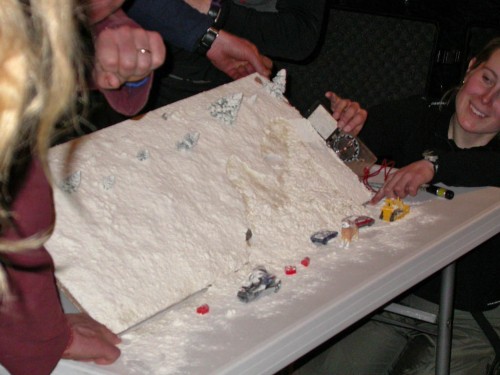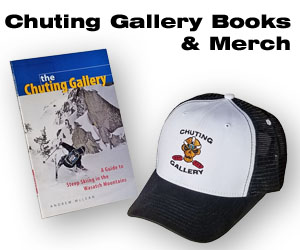Snap, Crackle & Pop – The ABC’s of Avalanches
The physics of an avalanche is as easy to understand as placing one book on top of another, then tipping the lower book up until the top one slides off. Voila – a bookalanche! The grip or amount of friction between the books will determine how easily they slide apart. If they are both dry and glossy, they’ll slide apart at almost any angle, but, if they have somehow bonded together through heat, humidity or moisture, you can turn them upside down and they may not come apart.

- One of my all time favorite avalanche education tools was this demonstration at the Alaska Avalanche School where layers of flour and sand are piled up on a flat board, which is then tipped up to 38 degrees where it rips loose and crushes the toys below.
This book example illustrates two important concepts of avalanches. One, avalanches occur when a bond (friction) fails, and two; it can be difficult, if not impossible to predict exactly when that bond will fail without some additional information. At times you could turn a mountain range over and shake it without the snow moving and at other times it will avalanche if you gently poke it with a ski pole.
______________________
For 15% off on a super-deluxe Pieps DSP transciever from Backcountry.com, click the photo below…
Category: 07 Avalanche Avoidance










In my Avy 2 class at Silverton they had something like that board using corn starch (I think) as snow. The really interesting part was that they’d randomly glued some rocks on the board and when the box was tilted and the slide went, it went along a line that centered along the rocks. It was a real illustration about how rocks poking through the snowpack don’t represent a safe area.
I made one of those avalanche boards when I worked for the CAIC. I used sugar (TG = faceted crystals) as my bottom layer (depth hoar) and then flower (for its slab quality) as my top layer. Then I would tilt the board up to 28 degrees (the board had a plumbbob inclinometer on the side of it) and then I would drop a Matchbox snowmobile on to the board. This would simulate a human trigger dropping in with too much force. This would trigger a nice avalanche…. Kids and adults both loved it….
In away thinking about it, maybe it made avalanches too entertaining……
Better than too boring. Anyway, as long as you were using a snowmobile how could it help but be entertaining?
The rock perforation idea is a dilemma. On one hand, rocks and trees form islands of safety, but at the same time, they can create weak spots in the snow which can cause a “connect the dots” fracture. In a few instances, I’ve been climbing up a marginal slope going from safe spot to safe spot, only to have the slope rip out just as you get to a rock! On one hand, you want to be close to the rocks, but on the other hand… not too close.